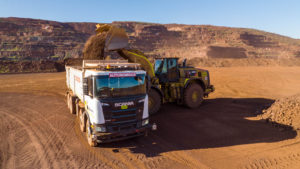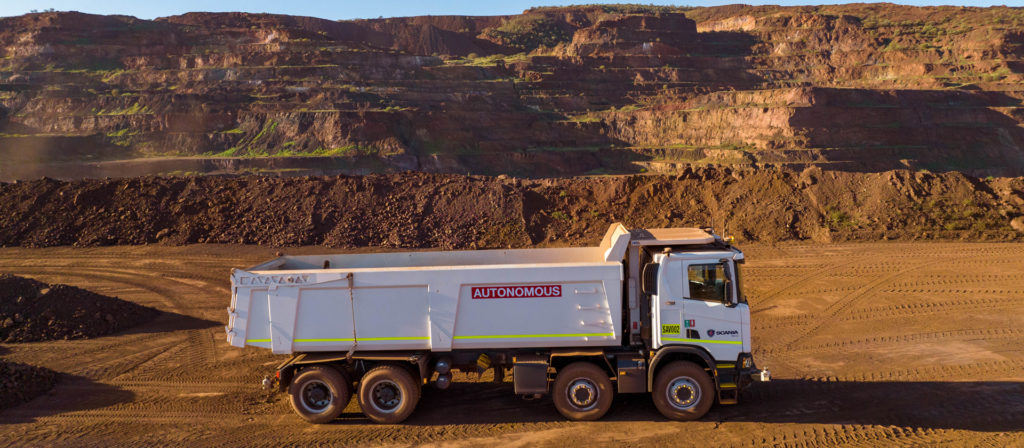Back in 2018, Scania announced that it had begun testing of a new generation autonomous transport system at Rio Tinto’s Dampier Salt operations in Western Australia. Rio Tinto has since revealed that this project has now moved additionally to the Channar iron ore mine in the Pilbara where work continues.
To get more insight into Scania’s strategy in mining when it comes to positioning its autonomous (and soon to be electric) trucks from an efficiency point of view, plus its progress so far, IM spoke to Daniel Bergqvist, who is Business Owner – Autonomous Solutions at Scania Group. He is commercially responsible for all customer collaborations on autonomous solutions aimed at the mining industry worldwide. This role includes setting and executing Scania’s strategy and roadmap for autonomous mining solutions with a focus on making sure it develops and deploys autonomous solutions for all the applications the mining industry needs.
Daniel Bergqvist, Business Owner – Autonomous Solutions at Scania Group

He is specifically working on mining on the commercial side but also works closely with the R&D team. Scania’s Autonomous Solutions group is working principally on two main projects – mining but also on-road hub to hub road transport. Then of course Scania also has a separate Scania Mining group that covers the trucks themselves as well as related technology and maintenance solutions. Bergqvist also worked within that group from 2010 to 2019 so has extensive experience with the equipment.
He told IM: “Scania takes on-road trucks and enhances them to work in mining including ruggedising the chassis and adapting the gearbox and axles, and we have done this for some of the most challenging markets in the world. These mining trucks have applications throughout the life of mine from exploration drilling support, infrastructure development, overburden removal, production, then closure and rehabilitation.”
Scania has been able to do direct comparisons for a number of years between its tipper trucks and large rigids in the main mining markets where it has major fleets – namely India, Indonesia and Brazil. It is bringing its Scania Mining learnings to its autonomous haulage work that is centred on Australia. It also has a lot of valuable data and experience from work at its own test facility in Södertälje near Stockholm.

Scania is now taking these proven mining trucks into the future making them first autonomous and then going forward, electric with zero emissions. But as the industry push for autonomy predates the push for electrification – that’s where it started. Bergqvist: “We opted to start with an autonomous version of our 8×4 mining tipper truck. As we have worked through adapting the components on that model for autonomy, we are now at a stage where we could convert any of our trucks to unmanned operation. The modular design makes for a lot of flexibility – for examples we could use a cabless version or even more axles – four or five or more – in the right application. The starting point, however, is that the Scania autonomous trucks have to be able to handle all the normal loading and unloading scenarios in a typical mine.”
What is the potential for smaller class autonomous tipper trucks in mining and where do they ‘fit in’ versus the established large rigid trucks? Bergqvist comments: “Today a lot of the mine hauls are getting longer, such as ROM ore to a crushing station or even to a port. In a deeper open pit you have the potential to have steeper walls due to being able to have narrower road widths due to the much smaller truck classes. Our trucks potentially also offer the ability to run at higher speeds on uphill hauls. The construction of that mine would also be cheaper due to the new design. Smaller trucks also have a lower initial capital cost, lower ongoing maintenance costs including components and tyres. We can use more conventional off-road tyres with a vastly lower unit cost.”
Scania is working out where the best autonomous use cases for these trucks could be – and in most cases it will be for greenfield operations as if a mine already has a large rigid truck fleet, they are not going to change it. There will still also be situations where bigger still is better.
The operation will need to be planned around smaller payload trucks. “If you have say 60 Scania trucks replacing 10 ultraclass trucks, then how many more loaders will you need?” It could be done with multiple wheel loaders but this is also why several of the big miners are looking at surge loading, in the form of the patented MMD Fully Mobile Surge Loader, to effectively decouple the excavator from the smaller trucks. “We are looking for example, at how our trucks would spot with this type of equipment. We are not just replacing big machines, we are also looking at mining in a different way – larger fleets of smaller trucks – but always where it makes sense.”
And why start in Australia? “Autonomous rigid truck fleets have been running in Australia for a long time now – it is the most mature autonomous haulage market by far. The big miners there have the experience but the legislation relating to the technology is also in place and well embedded. There is also an obvious cost issue drive due to the high cost of operations and operators there.” Lastly, the top tier miners in Australia have very exacting standards especially with regard to safety – so if the technology is proven there, it should open the door to application anywhere else in the world.
On the Scania autonomy system itself, similarly to other players it uses external sensor suppliers but the software and system itself are fully developed in-house. “Our focus is to use LiDAR and radar to deliver a very robust and reliable solution. It is also completely open – we can work with any fleet management system. Whether it is off-road or on-road our autonomy has always co-existed with a range of other technologies and mining is no different. That is also what the major mining groups want and expect. We are also very willing to be part of the ISO 23725 standard as that evolves.”
He added on wider conversations with the mining sector: “We are talking to a number of mining groups because we want and need their inputs and requirements as we have to be sure it works for everyone. Once we have a commercial offering we want to be able to slot it into their operations.”
Regarding electrification, it will be much easier to run a larger fleet of smaller battery trucks, with the technology around ultra-class battery haulers still very much in early development but for smaller trucks it is much more near term and more practical with today’s battery technology. Scania is looking at the right size of battery for its 8×4 and the right associated motors and components, as well as the right fast charging system to make sure it works effectively in mining.
But it also is already getting battery truck experience – a Scania electrified 25P truck with trailer, with a total weight of 74 t including load and trailer, has begun operating as of September 2022 having been deployed by Renfors Åkeri AB for metal concentrate haulage on behalf of miner Boliden on a 30 km return-trip route on public roads from the Renström mine in Skelleftea to the Ronnskar smelter in Västerbotten, northern Sweden. It is using plug in fast charging but of course as a battery truck it has a much higher GVW that a diesel truck so Scania is making sure it works from a practical point of view.
“We are committed to developing these batteries not just for mining but for other industries and we are doing it quickly. Crucially for mining, once we have a battery truck design for mining finalised, our production set-up means we will be able to produce large numbers of them and the modular design means we can also offer various different configurations from a 4×2 flatbed to an 8×4 tipper or water truck.”











